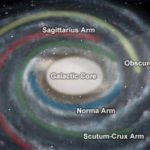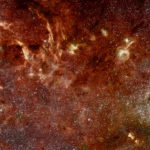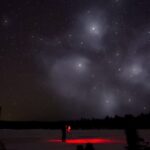In the middle of our home-galaxy is a a vast region of Space with far more stars than all the others –and, in the distant future and forever after that, the biggest part of the biggest tree.
–
Table of Contents:
- Location
- Volume
- Density & Composition
- Galactic Core (GC)
- Galactic Center (GCP)
- Additional Notes
- 2023 Notes, Ideas, and Calculations
- 2300 Update
- 6,900,002,012 Update
–
Location:
The Galactic Core (GC) is the region of our galaxy between the two opposing (solar system cluster) arms of the Galactic Bar (GB), inside the denser, brighter orb of solar systems, extending out from the Galactic Center Point (GCP) to a distance of roughly 50,000 light-years (LY).
–
Volume:
The GC is ~12,000 LY in diameter. That makes this section of our galaxy roughly 905,000,000,000 cubic-LY (as in LY^3), dependent upon the relative orientations and fluctuations of all of the orbital routes of the solar systems that comprise this galactic entity. That number is derived from the sphere volume formula: [(4/3)π⋅r^3]. If one includes the entire area (volume) not just 6,000 LY out from GCP, but 50,000 LY from that point, the volume becomes 523,598,775,598,299 cubic-LY.
The total amount of space (volume) occupied by the ‘flat’ (~1,000-LY thick, on average) portion/disc of the Milky Way galaxy (MWG) is estimated to be several trillion cubic LY. [π⋅(50,000 LY)^2]⋅(1,000 LY)] = 7,850,000,000,000 cubic-LY. Thus the MWG is roughly 8.674 times as big/voluminous as just its GC section; the GC occupies ~1/9 of the total MWG volume.
–
Density & Composition:
The MWG’s GC is very dense compared to the rest of MWG Space; there are far more stars packed into this 1/9 of the total MWG ‘area’ (volume). More than half of the solar systems in our Milky Way galaxy are located in this innermost section, giving it an estimated solar system tally of 100-to-200 billion solar systems, many of them including multiple stars, shared stellar orbits, dozens of planets, and some with even thousands of moons and even more planetoids, nearly one-quarter of which are Class M worlds (Earth-like; “garden planets”), needing no terraforming at all, and nearly one-half of which are colonizable with either minor or standard terraforming, or ‘bubble biome constructs’. All the atoms of the Periodic Table of the Elements are present throughout this region of local Space.
–
Galactic Core (GC):
(but not quite the center of the core, which is the GCP)
- While we (the people of Earth and the 34 Tauri system) are in the ‘suburbs’ of the galaxy, this is the urban/city-proper area.
- Everything is closer together in this galactic region, so there are not L.Y.s between solar systems; just thousands of A.U.s (*Pluto is 39.53 A.U.s from the Sun, while the Oort objects are between 5,000 and 100,000 A.U.s). On average, stars here are only 1,000 AU apart; ~1 Light-Week (as opposed to a Light-Year (LY)). This means that most worlds here have more than 1,000,000 stars in their night skies which are brighter than Sirius, thus their night skies are 200x brighter than the light of the full Moon.
- Solar radiation would still be based on proximity to the star, so sunburns wouldn’t be worse, but nocturnal animals would only develop in rare, steep, deep valleys and caves, as it would be day-level bright almost all the time elsewhere, excepting during heavily overcast times such as during seasonal storms like the hurricanes and typhoons of Earth.
- Interstellar empires encompass far more solar systems here due to how much less energy it takes to travel between systems, and that means wars and debris fields (and debris nebulae) are more common here.
- When stars here go nova, it affects more worlds, sometimes setting off sequences of novae like a daisy-chain (linked bombs which function similarly to a chain reaction).
The GC is a very active region of MWG Space, with countless ruins and civilizations just about everywhere, nearly all of them in regular contact with one another, as well as (in) trade. This makes most people from, or at least living in, this region of Space (and in comparable regions of other galaxies), much more accustomed to languages, linguistics, diplomacy, teamwork, etc. It also has kept many, perhaps most, of them more closely related over the generations and eons; they can sense and understand one another (even across the gaps between their worlds and systems) better than humans on Earth pick up on what their neighbors and extended family/relatives are doing/feeling/wanting.
Because of its size, density, and brightness, the GC keeps 20-30% of the rest of the MWG beyond line-of-sight to anyone in any solar system outside it. On Earth, for example, we cannot see what is on the other side of the GC, even with our finest telescopes and other devices. The only way for people from Earth to determine what is on the other side of the GC… is to go where those portions of the MWG come into view.
–
Galactic Center (GCP):
(the center of the core of the galaxy)
- This is the ‘downtown’ / ‘inner city’ part of our galaxy.
- Stars are only 100 A.U.s apart here; ~2.5x the distance of the Sun to Pluto.
- There is a super-massive black-hole (2.6 million Sol masses) which causes some solar systems and rogue stars to orbit it at extreme speeds; some stars and their solar systems orbit this black-hole like planets and moons would orbit a star, some of them taking only 20 years to make a complete orbit of the black-hole. And this black-hole probably only needs to eat one star every 5,000 years to sustain itself.
- The stellar density near the Galactic center is ~1,000,000 (100x100x100) stars per cubic parsec (compared to ~1 star per cubic parsec in the stellar neighborhood).
- The night sky on worlds in this central spot of the galaxy would be painfully bright to creatures from Earth, and the stars would visibly move in the sky almost as quickly as airplanes fly on Earth.
People in the GCP live and travel so close to one another, compared to people elsewhere in the MWG, that they all sense and see themselves as one family, almost one race of one species. Most of them actually are, in fact, of the same (angelic) proto-race/species. Even during the Mayan triple-calendar consciousness-focus transitions and changes, including during the chaotic near-Shift years/generations, the people in this part of the MWG remained very closely connected, maintaining much greater mental clarity and social stability this way, and so never drifted apart linguistically or in any other way.
Think of people in the GCP like the particles and photons of the Super-Massive Black-Hole (SMBH) that is said to be here and causing this tighter-grouping of stars central to the galaxy; they are so close, in so many ways, that not even their light/wisdom ever seems to escape, and they remain strong enough to disregard even the influence of other passing stars. This is a whole ‘nother level of ‘racial purity’, a.k.a. cultural stability. People here simply do not war.
–
Additional Notes:
For comparison, here are some details about solar systems on/in the Galactic Fringe (GF):
- This is the rural part of the galaxy.
- At the ends of the spiral arms of our galaxy, and in the spaces between them, the night sky would be almost completely blank and pitch black, void of any visible stars except the faintest blurs from the densest parts of the galaxy rising in the sky only for a few hours on nights with no moonlight.
- Nocturnal animals would evolve and dominate with ease here. Eyesight would be less utilized by nature; instead, animals would likely use radar (like bats do), smell (like bears, bees, and wolves do), and infrared/heat sensory organs (like snakes do).
- Astronomy would take millennia longer to develop on worlds here, or to even be thought of in the first place.
- The light of hyper-giants starting to glow in the initial stages of stellar ignition here would be brighter than many stars within their own solar systems out here.
- Travel between systems would take much more energy, thus also take much longer, so civilizations would be much likelier to be isolationistic, xenophobic, and even the cosmic equivalents of uncultured, sheltered, close-minded racists.
- Earth is part of a solar system in a section of one of the galactic arms, that section being part of the GF, and this is a big part of why it had so little unity, peace, or prosperity/continuity in the later years/eras of the Mayan triple-calendar schedule/evolution.
This means that cosmic habitable regions, a.k.a. Goldilocks Zones, are much more common, and sometimes overlapping, in the GC (as well as, in some places, only existing for a time, or only doubling up (overlapping) for periods of time, thereby leading to the evolution of VERY mobile and/or hardy lifeforms and civilizations), and especially in the GCP, while out near the edge of the MWG… they are far apart, and sometimes not present at all.
Finally, remember that all stars are angelic beings; arch-angels, angels, and more, meaning you can talk with them, and that they create other elemental / multi-dimensional ‘children’. The stars are ‘dancing’ in this formation we call the Milky Way galaxy for a reason, and it is not mere chance, for they exist in the purest state of mathematical relationships incarnate/manifest. You can access the Webway that is Yggdrasil; the living and dynamic portal/tunnel-like links between, and connected by, them all, but to truly understand why stars are the way they are… you must take the time to stop and commune with many of them (even though they are essentially like the Inisfreeans; one mind in many bodies, each able to represent all). Those who were born out where multiple star’s energy fields overlapped… were created with the combined essence and visions/designs of both those giant angelic beings (stars), thus they can easily handle life on all the worlds that only have the light/energy-type of one or the other (kind/type/class of star) –and they can easily access the mind/information of all stars in the family-like networks of any/all the types whose light they were born under/within, …so beings from the GC, and especially from the GCP, can connect you with more of them… if not them all.
Stars are not just fuel generators for worlds, or even just secret gateways to the network that connects them, but are also channels providing streams of information/awareness/wisdom to all whose blood is close enough to that of the angelic children of that star (or, in Earth’s case, when the humanoids on Earth are related closely enough to the race of elves which sent one of their own to become Earth’s current star). That is why some bad beings posing as human authorities/billionaires in the near-Shift (chaos-like) times/era on Earth tried to develop technology to block out some of the Sun’s light; they could not interpret it, for they were born of the darkness/evil/incompatible, but they still knew it was not merely mindless streams of photons… but incredible and endless information from the entire angelic race/network, unstoppable by anything short of volcanic eruption clouds and global nuclear war… or cloud-seeding via chem-trails paired with HAARP/SBX-1 rays. The stars communicate and help us live and move with/via their light, as it is the holy/natural bioluminescence of the elves who formed from the angels/omni-dimensionals who came to each world to help complete its shaping; blocking the light of those people is an attempt to disconnect us from them, thereby maintaining the near-Shift chaos/unrest a little longer.
For those able to sense this, and access the network linking all stars (angels), and travel to the GC and its GCP, things like this become known, then transmitted out to all around that enlightened (pun not intended) individual upon their return. Even when they only travel via astral projection through the network of stars, not even on a ship of an SSP, such becomes undeniably known. More will follow.
–
2023 Notes, Ideas, and Calculations:
“This is downtown where all the actions is.”; solar-systems are much closer to each other here, resulting in easier contact, travel, and trade between them. (In fact, some of them have remained in contact with each other, never having lost it or warred –for their entire existence; some have been healthily populated/colonized since the very formation/stabilization of their worlds.) The central star is older; it has had longer to perfect its vision, thus manifest/maintain perfect orbits –strange or fast from the Earth-humans’ point of view as they may seem. You get the idea; everyone is better connected here, and it is much easier to get work or help; whatever you want or need done –even across the distances between the worlds and their stars.
In stark contrast, the Sun is on/near the fringe of the galaxy, no unlike a remote-wilderness town rarely visited (or even known about by most) and less-developed, new and still learning –and sometimes barely holding on. (Even though the Earth is Midgard; one of the first realms, and start of a LOT of the Universe, it is now on the fringe of what Creation has become.)
There are around 10 million stars within one parsec of the Galactic Center, dominated by red giants, with a significant population of massive super-giants and Wolf–Rayet stars from star formation in the region around 1 million years ago.
When radius = 1, volume = 4.19
4.19 cubic parsecs = 145.3756 cubic light-years
10,000,000/145.3756 = 68,787.33432 stars in every cubic light-year in this region
The closest star to our sun is about four light-years away; in the center of the galaxy, stars are only 0.4–0.04 light-years apart.
Stars in the galactic center or core region are at least 10x to 100x closer to each other; 100x easier to get to, just like it is ~100x easier to drive to a store in your town than it is to arrange a trip to another state or country; it is the kind of thing you do every day without even giving it much thought.
.4 LY = 2,351,000,000,000 miles
.04 LY = 235,100,000,000 miles
The average distance to Pluto is 3,311,000,000 miles.
2,351,000,000,000/3,311,000,000 = 710.0573844
Stars in the galactic core are at a distance from each other 71x to 710x the distance we are from Pluto.
With stars that much closer to one another, the effects of their own zodiacs have been much stronger, thus more unity, less variation, and fewer misunderstandings.
Imagine if our planets were also 71x to 710x closer.
Imagine if the Moon was.
(not 238,900 miles away, but only 3,365 to a mere 337)
Imagine if stars were 71x to 710x bigger or brighter; worlds in the galactic center likely all see many stars during their daytimes, and far more than we can even during our nights.
The tradeoff is that the light from all their closer stars may blur or block out what would be their own views of galaxies outside the Milky Way.
10,000,000 stars in one uniform volume can be simplified as ~215 x 215 x 215; imagine about 200 to 250 solar systems lined up, then form a cube or sphere with that span.
The composite image of the galactic center is 32.5 arcminutes (246 light-years or 75.5 parsecs) wide.
When r = 37.75, volume = 2.25×105
225,000 cubic parsecs = 7,806,567.94 cubic LY
If solar-system dispersion was uniform throughout the whole galactic center, not just the first parsec out from the MWG’s central SMBH, we could estimate the total number of stars in this region this way:
225000/4.19 = 53,699.28400
53,699.28400 x 10,000,000 = ~536,992,840,000 stars in the galactic center,
but with only an estimated 100,000,000,000-400,000,000,000 stars in the whole galaxy, and the galactic core occupying only a small percentage of its volume, there are likely closer to 200,000,000,000 stars in the core, and the rest out in the arms.
There is also the halo region.
It is considered not visible from Earth, but its presence has been determined due to effects on the orbits of many other stars.
It extends far beyond the ~100,000-LY diameter of the portion of the MWG visible to us, but just how far into the Intergalactic Medium / Deep Space is unknown.
Its mass is several times more than the rest of the regions of the galaxy, combined.
The mass of the MWG is estimated to be ~1,000,000,000,000 solar masses.
(With 100-400 billion stars, after subtracting the 4,000,000 solar-masses central SMBH, that means an average of 2.5-10 solar-masses per star. Since only ~4% of stars in the MWG are calculated to be bigger than the Sun, that means 1) if most stars are more massive, then they are denser, and 2) other black holes, SMBH-level or not, account for that average suggesting most stars are more massive than the Sun.)
–
2300 Update:
The Inisfreeans (ICVs) now know everything about this part of their home-galaxy, having explored it in person themselves for many years. Their preparations during the centuries before have helped manifest what is here. Their presence here just a few decades ago confirmed and further perfected those manifestations, laying the foundation for the next major campaign they had foreseen: restoring the legendary realms-linking mega-tree that had once been here and beyond.
–
6,900,002,012 Update:
The Worlds Tree has reformed/reappeared enough that it connects to a number of worlds here, its mega-branches following the galactic spiral-arms, connecting to a sequence of many other solar-systems. For the next few billion Earth-years, its mega-trunk will continue growing out from the SMBH at the center of this region of the Milky Way, eventually connecting two adjacent galaxies; one above, and one below. That SMBH now, by the way, is no longer a Black Hole; it gave up a huge portion of its mass to help form the local section of the Worlds Tree’s trunk which is now growing here –but that doesn’t make this part of the MWG brighter; the Worlds Tree is using and blocking a significant portion of all starlight here.
From now on, the start and midsection/center of the Worlds Tree’s trunk will be here; the core of the Milky Way is the new / post-Shift Midgard, central realm of Creation / the Omniverse.
–
–











